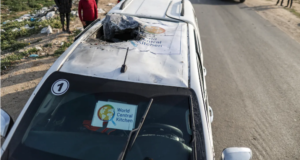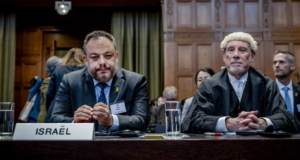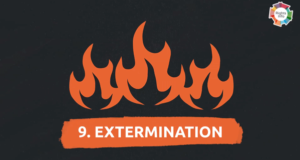Ewa Jasiewicz | The Palestine Telegraph
16 September 2009
It happened at 2:30am, Wednesday, December 31 2008. Israeli helicopter gunships and warplanes had been bombing the length of the Gaza Strip. In Eastern Jabaliya, white phosphorous had been exploding over Ezbit Abid Rubbu, Al Gerem, and Jabal al Rais.
Jabal Al Rais, the President’s Mountain, renamed “The Mountain of Fire” because of the resistance in the area against incoming Israeli forces, was where Dr Ihab al Madhoun, 34, and Mohammad Al Hassira, 21, had driven to rescue suspected casualties. Both medics were inside their ambulance when it was struck by Israeli missile fire. Hassira, a medical volunteer, died instantly.
Madhoun, suffering shrapnel injuries to the head and neck lived until midday the following day. Visiting him in the Kamal Odwan Hospital in Jabaliya, I saw the experienced doctor lying bandaged up, semiconscious, with blood and brain fluid seeping from the back of his skull, writhing in pain. Hasira and just hours later, Madhoun, would join 14 other medics who lost their lives, most in the line of duty during Israel’s 22-day attack.
During Israel’s Operation Cast Lead in December 2008 – January 2009, Israeli forces killed 16 emergency medical staff and injured 57, including at least four who needed leg and arm amputations. Thirteen of the medics killed worked for the Civil Defence Service (CDSS)-a mixture of fire fighters and frontline emergency medical personnel. Eleven fire fighters were also injured, their red engines bearing bullet holes directly targeting drivers.
On the first day of Israel’s attack, Israeli warplanes destroyed half of all of the CDS’s 16 offices in the Gaza Strip. In the central governorate of Diere Balah every single CDS building was reduced to rubble within five minutes of the first attack, and tens of staff members killed. Bodies continued to be pulled out of the rubble for days after the initial bombardment.
In one day, 235 police officers, including CDS staff, were killed-an attack human rights lawyer Daniel Machover of UK legal firm Hickman and Rose claims should be recognized as a war crime. “It was a premeditated, pre-planned attack on civilian institutions, including the coming out parade of a police academy. These were not military targets, and as such, there is strong evidence to suggest the bombing of these was a war crime.”
The CDS had four of its eleven ambulances wrecked. With 600 trained rescuers, the service needs ten more to be working at full capacity. During Cast Lead the CDS was working at ten percent capacity, lacking basic equipment such as protective vests and powerful torches. “Despite 50 percent of our equipment being destroyed in the first day of the attacks, we answered 1300 cases and worked 24 hours a day,” explained Mohammad Al Atar, Chief of the CDS in Gaza.
The CDS has trained 50 women through the Ministry of Youth and Women’s Affairs to take on some of the toughest work in Gaza. Al Atar says, “A mother cannot protect her children-a child could be shot in her arms. The Palestinian woman needs training in Civil Defence to protect her family-this is a national duty.” Despite this, CDS staff has been denied uniforms for the past two years by the Israeli authorities, relying on their own thrown-together luminous orange vests and jumpers.
Not protected
The IDF’s Gaza Coordination and Liaison Administration (CLA) implied that the CDS rescuers were not protected under international law because they are “combat medics.” However, even medics tending to combatants are still protected. “Their medics were part of the Hamas medical staff and were similar to combat medics that we have in the IDF in the sense that they are soldiers,” the head of the CLA Col. Moshe Levi told The Jerusalem Post in February. Reporting for Israeli daily Ha’artez in April, Israeli journalist Amira Hass wrote of evidence of Israeli soldiers being given rules of engagement that told them to “Fire also upon rescue.”
Traumatic experiences for Palestinian medics are part of their work. Mohammad al Hissi, 34, a Gazan paramedic was part of a team struck by an Israeli artillery shell in Sudaneya in March 2002. His colleague and chief medic Sa’ed Shalai was killed, joining four other senior medics killed in the West Bank and Gaza in less than a week. Hissi, pierced all over his body with shrapnel, was brought into the emergency room with virtually no pulse. “It’s a miracle I survived,” he told me, driving his Red Crescent ambulance through the now liberated if besieged streets of Khan Younis. Colleagues called him a living martyr for months afterwards. “But I couldn’t work for about year after the attack. I just couldn’t bring myself to go out into the field again. I took on desk work, taking calls. Then when I healed, I got brave again and returned.”
Gazan medics crave relief, decompression, a break from their horrific experiences. One of Gaza’s longest serving Red Crescent medics, Ali Khalil, aged 47, was part of the team which brought the body of infant Shahed Abu Halima from the ravaged northern district of Atatara during a brief respite in Israel’s attack. Medics had been denied entry to the area for days. Despite coordination with the Red Cross, ambulances had been repeatedly fired upon, forcing medics to turn back empty-handed.
Ali found Shahed lying on the main sandy road to Atatara. “At first I thought it was a doll,” he said. She was red, bloated and her legs were missing-she had been half eaten by dogs. “I see her in my sleep,” says Ali. “I have nightmares about it. We need a rest; we need help. I think some counseling would help all of us.”
Attacks on medics are not limited to invasions. Ali’s ambulance was shot at in April whilst trying to collect two injured Islamic Jihad fighters at the border area of Ezbit Abid Rubbu in Eastern Jabaliya. The two were unable to move but were still alive when Ali tried to reach them. Unfortunately he was forced to turn back, and when he finally returned a few hours later the casualties were dead, their bodies pumped full of bullets by Israeli snipers.
“Coordination”
“I have only one coordination”, says Mahmoud Abu Speitan, Director of the Amul Hospital Red Crescent Training Institute and veteran paramedic from Khan Younis. “Ashahadu Lā ilaha illal-Lāh, Muhammadun rasūlula-Lāh,” (I testify that there is no god but God and Mohammad is his messenger)-a blessing commonly declared by Muslims when expecting to die. “This is what I say when I get inside my ambulance.”
“Coordination”-Tanseek in Arabic-refers to permission from the Israeli Occupation, organized through the International Committee for the Red Cross, to enter areas to collect the dead and injured. During Israel’s attacks in December and January “coordination” was only granted in some cases after four days-as was the case of the Samouni family, which saw over 30 people from the same family killed when homes they were sheltering in were shelled by the Israeli army.
Medics from the Tel Al Howa station close to Al Quds Hospital-which was later bombed by an F16, shelled by tanks and gutted with white phosphorous-had to walk for over a kilometer dragging a donkey cart on foot because Israeli forces banned them from taking either an ambulance or a donkey. The medics said they could not forget the white parched mouths of the child survivors they found clinging to the bodies of their parents. They dragged the injured, limp and jostling around, on the back of the carts as Israeli soldiers looked on.
Articles 14-24 of the Fourth Geneva Convention afford special protection to medical and humanitarian staff. The Convention guarantees respect for the freedom of movement of medical personnel, and ensures they be granted all necessary material facilities to perform their duties, including removal of victims, and attending to and transferring injured and sick civilians. Care of and access to the sick and injured are also enshrined in Article 17, which states that “the parties to the conflict shall endeavor to conclude local agreements for the removal from besieged or encircled areas, of wounded, sick, infirm, and aged persons, and for the passage of ministers of all religions, medical personnel and medical equipment on their way to such areas.”
According to the Palestinian Centre for Human Rights (PCHR), perhaps hundreds of those killed could have survived if emergency services had been able to access them promptly-the access denied to them can be defined as a deliberate violation of the Geneva Conventions and therefore a war crime.
Throughout Israel’s war on Gaza, basic, essential medical supplies and equipment including Personal Protective Equipment (PPE) were in short supply. After nearly two years of a hermetic siege, even basics like gauze, electric blood pressure monitors, spare parts, and petrol were scarce. Ministry of Health (MOH) teams in the north lacked walkie-talkies, relying instead on coordination through other services, and trusting their hearing to follow the sounds of falling bombs. The MOH ambulances in Jabaliya ran out of petrol in the final days of the attack. Concerned residents joined together to bring canisters of fuel to their operating base at Kamal Odwan Hospital and an entire convoy from the north swung into the headquarters of the United Nations in Gaza City to literally beg the UN to let them fill up.
Protective vests were limited to around four per station, meaning team members had to take turns wearing them. Perhaps, if the much admired paramedic Arafa Abdel Deim had had the luck to wear his on a run to rescue five shelled casualties, he would have survived the direct flechette shell that hit his ambulance. He died of massive blood loss. The vests the medics use-primarily in the hands of the Red Crescent, the Palestinian arm of the International Red Cross-are inadequate for the quick lifting of casualties. Made of two heavy plates of steel, they weigh down on the person like a Knight’s armor.
Ambulance crews with the CDS lacked high voltage searchlights-essential equipment for night-work. Every second spent searching fruitlessly means a second closer to a potential re-hit by Israeli forces or a second closer to a casualty turning into a fatality. Medics ended up using tiny cube-lights, shining a thin hazy beam stretching just a few feet in front of them.
Unity and solidarity
In April of this year, medics from the CDS, MOH, Union of Palestinian Medical Relief Committees, Red Crescent, and Military Services met together to establish an organizing committee for an “International Campaign of Solidarity with Palestinian Emergency Workers.” The group of over 50 gathered together to speak in a common voice, despite Israel’s attempts to divide them into categories of “legitimate” and “illegitimate” or “combat medics.”
The aims of the nascent campaign are to mobilize the international community to react to Israeli violations of international law; to stop attacks on emergency staff; to build advocacy for the observance of international law; and to organize the twinning of ambulance stations in Gaza with others around the world. The campaign also aims to secure badly needed equipment, engage in staff exchanges, and build a louder, more public and unified voice for Palestinian rescuers internationally.
According to the MOH, 100 rescuers have been killed in the past nine years-an average of one per month. To date, there has been no political cost or accountability for Israel’s targeting of Palestinian rescuers. We need to turn the spotlight on the occupation’s targeting of medical professionals-the front line in civilian resistance to Israel’s policy of massacre, collective punishment and community devastation. Making it too politically costly for Israel to keep killing rescuers is imperative to saving lives.
Solidarity campaigning for Palestinian human rights has been active since the 1948 establishment of the state of Israel on stolen and ethnically cleansed Palestinian land. A 60-year history of dispossession, massacres, home demolition, extra-judicial killing of leaders, imprisonment, land grabs, and invasions keeps repeating itself. Generations of Palestinian emergency staff have been responding to these invasions and attacks by putting out the fires that Israeli bombs have ignited, picking up the pieces of broken bodies that often break families and communities, and saving the lives that Israel wants to kill-civilian or combatant. Referred to in the Palestinian community as “unknown soldiers,” these courageous men and women are frontline witnesses to the effects that white phosphorous, flechette shells, missiles, sniper fire and bulldozers have on the human body. As such, their witness to Israeli attacks is up close and personal and hard to refute.
Medical services fulfill a strategic aim of keeping Palestinian communities together, and defending their survival on their land. They have rescued 40,000 Palestinians injured by Israeli forces since the eruption of the second intifada alone. Supporting them is key to resisting Israel’s policy of ethnic cleansing and massacre. “When we put on our uniforms, we are life-savers, it doesn’t matter who we support, which Palestinian side, we have to save lives, even those of Israeli soldiers-that’s our job, it’s the promise we make,” explains Abu Issam, a senior Paramedic with Jabaliya’s Red Crescent Society.
Following Israel’s massacres in January 2009, the number of applicants for rescuer and ambulance driver training in Gaza soared. Many Gazans were traumatized by hearing friends and family members calling local radio and television stations begging for ambulances to collect their bleeding loved ones. The rage over those who could have lived if Israel had not attacked those trying to save them has turned into a practical resistance of young men and women being prepared to sacrifice their own lives in the service of preserving the lives of others. We need to support this resistance and defend these rescuers as a clear form of “solidarity triage” in the midst of the intensifying attacks on Palestinian communities and their land.
 International Solidarity Movement Nonviolence. Justice. Freedom.
International Solidarity Movement Nonviolence. Justice. Freedom.


